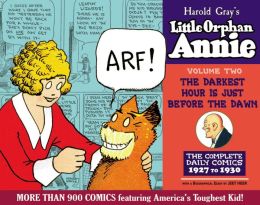
Before I get going, a brief remark on something I said in my previous LOA review... Do any of you follow the current ANNIE strip in your local newspaper? The major makeover of eight or nine years ago seems to have made Annie more of a clone of Gosalyn Mallard than ever! The modern Annie doesn't have a ponytail and isn't wearing "pump-up" sneakers, but she should be. To paraphrase a line from Gosalyn in "Darkly Dawns the Duck" : "When you have a lotta spirit, everyone else's eyes seem empty!" :-)
Volume 2 of the Harold Gray reprint parade brings us strips from 1927-1929, and, this time, a number of color Sunday pages are included. For a short period of time during 1928, Gray maintained his continuity in both dailies and Sundays before abandoning the practice with the strip of Dec. 30. A few years later, he would merge the two for good. Why he experimented in this way, I haven't the foggiest. Annie starts the volume in the company of Daddy Warbucks and reunites with him once before it's through, but not before Gray drags us all through the wringer by, first, getting Annie in bad with a bunch of train robbers (who stage a vengeful kidnapping after the spunky kid has doped out where they hid their stolen loot) and then dumping her back into nasty Miss Asthma's Orphans' Home for a long, painful spell, even as Warbucks is literally tearing the town apart trying to find her. The juxtaposition of Warbucks' frantic actions, Annie's spells of misery, and colossally unfunny Sunday-page gags in which Annie, purposely or otherwise, gives Miss Asthma grief is almost too much for the reader to bear. Gray eventually tires of this game and uses the convenient medium of a fire to (1) level the Orphans' Home, (2) wipe out any trace of Annie's pre-Orphans' Home history, and (3) literally force Annie and Daddy back together. Gray lets Annie rest on her hard-earned laurels for a while, then incapacitates Warbucks in a plane crash. Soon thereafter, Warbucks is off again trying to save his fortune, and Annie -- because she can't remember the name of the city hotel where the two were staying (!!!) -- is forced back into the "madding crowd." By volume's end, she's in the town of Blunderville with a kindly seamstress and playing more or less of a secondary role in a mini-drama of unwise stock-market speculation that's far too close to the contemporary headlines (read: The Crash of '29) for comfort.
During this period, Gray tackles the subject of "collective worker action" -- a future bugaboo of his -- for the first time and emits decidedly mixed signals. In the town of Mayfair, Annie gets a job as a waitress at a railroad beanery, then decides to strike as a result of unfair treatment. Gray doesn't seem to have a problem with this, perhaps because the strike was called by an individual in this case. When Warbucks later argues at great length with farmer Silo about the "farm situation" -- a major issue in the otherwise prosperous 20s, and one that Gray knew quite a bit about, since he came from a farming family -- Gray appears to be advocating, if not quite a farmers' union, then certainly more effective cooperation among farmers so that they can air their grievances more successfully. Gray then counterbalances these progressive touches with a Labor Day strip in which Annie makes a comment about small-town people being able to work when they care to, since no unions are involved. Gray's views on this subject would calcify soon enough once unions became an important part of the New Deal coalition, but, here, they're very much in flux. (By the bye, the long wrangle between Silo and Warbucks over farm policy definitely dispels any illusions that Gray meant for his strip to be read primarily by kids. The juvenile-friendly version of Annie that gained popularity on radio in the 1930s must have seemed almost like a completely different character to those deeply familiar with the progression of the comic strip.)
Jeet Heer's ongoing essay on Gray -- in this segment, he discusses the debts that Gray's storytelling style and themes owed to Charles Dickens -- continues to be interesting reading. A bonus of sorts is included in the form of a mock-serious summary of the continuities contained in Volume 1. The flippant tone ("They made a trapeze performer out of [Annie]. She really should have sent [her doll] Emily Marie in to perform. But she didn't. And the rope broke. And so did Annie's legs.") makes me wonder if this was meant to be a parody of Gray's habit of summarizing recent strip events in occasional "catch-up strips." If so, it was quite funny. If not, someone at IDW has a peculiar sense of humor.
No comments:
Post a Comment